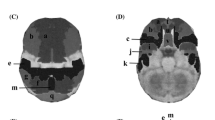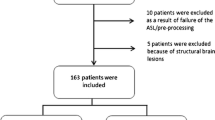Abstract
Purpose: To determine the usefulness of brain perfusion SPECT for evaluating the severity and progression of Alzheimer's disease (AD).Methods: Eighty-four AD patients were included. At entry,99mTc-HMPAO-SPECT, the Mini Mental State Examination (MMSE), Mental Function Impairment Scale (MENFIS), and the Raven Colored Progression Matrix (RCPM) were performed for all 84 patients. During the follow-up periods, two individual MMSE evaluations in 34 patients, two MENFIS evaluations in 30 patients, and two RCPM evaluations in 20 patients were performed. Based on the regions of decreased cerebral blood flow demonstrated on 3D-SSP images of SPECT, the cases were classified as type A (no decrease), type B (decreased blood flow in the parietal or temporal lobe), type C (decreased blood flow in the frontal lobe and parietal or temporal lobe), type Pc (decreased blood flow in posterior cingulate gyrus only), and “other types”. The types of decreased blood flow, scores on neuropsychological evaluations, and symptom progression were analyzed.Results: The MENFIS, MMSE, and RCPM scores were poorest in type C patients at entry. The degree of decrease of these scores during the follow-up periods was also greatest in type C. The greatest difference between patients with and without rapid progression in SPECT data of the mild AD patients (MMSE score ≥ 24) was in the frontal lobe.Conclusion: Decreased blood flow in the frontal lobe of AD patients is correlated not only with reduced cognitive function at the time of the evaluation but with rapid progression in the subsequent clinical course.
Similar content being viewed by others
References
Minoshima S, Frey KA, Koeppe RA, Foster NL, Kuhl DE. A diagnostic approach in Alzheimer's disease using threedimensional stereotactic surface projections of fluorine-18-FDG PET.J Nucl Med 1995; 36: 1238–1248.
Kubota T, Ushijima Y, Yamada K, Okuyama C, Kizu O, Nishimura T. Diagnosis of Alzheimer's disease using brain perfusion SPECT and MR imaging: which modality achieves better diagnostic accuracy?Eur J Nucl Med Mol Imaging 2005; 32 (4): 414–421.
Hachinski VC, Iliff LD, Zilhka E, et al. Cerebral blood flow in dementia.Arch Neurol 1975; 32: 632–637.
Barber R, Snowden JS, Craufurd D. Front temporal dementia and Alzheimer's disease: retrospective differentiation using information from informants.J Neurol Neurosurg Psychiatry 1995; 59: 61–70.
Homma A, Niina R, Ishii T, Hasegawa K. Development of a new rating scale for dementia in the elderly: Mental Function Impairment Scale (MENFIS).Jpn J Geriatr Psychiatry 1991; 2: 1217–1222.
Folstein MF, Folstein SE, McHugh PR. “Mini-mental state”. A practical method for grading the cognitive state of patients for the clinician.J Psychiatr Res 1975; 12 (3): 189–198.
Aftanas MS, Royce JR. A factor analysis of brain damage tests administered to normal subjects with factor score comparisons across ages.Multiv Behave Res 1964; 4: 459–481.
Minoshima S, Giordani B, Berent S, Frey KA, Foster NL, Kuhl DE. Metabolic reduction in the posterior cingulated cortex in very early Alzheimer's disease.Ann Neurol 1997; 42 (1): 85–94.
Minoshima S, Koeppe RA, Frey KA, Kuhl DE. Anatomic standardization: linear scaling and nonlinear warping of functional brain images.J Nucl Med 1994; 35: 1528–1537.
Minoshima S, Koeppe RA, Frey KA, Ishihara M, Kuhl DE. Stereotactic PET atlas of the human brain: aid for visual interpretation of functional brain images.J Nucl Med 1994; 35: 949–954.
Talairach J, Tournoux P.Co-planar stereotaxic atlas of the human brain. New York; Thieme.
Herholz K, Salmon E, Perani D, Baron JC, Holthoff V, Frolich L, et al. Discrimination between Alzheimer Dementia and Controls by Automated Analysis of Multicenter FDG PET.Neuroimage 2002; 17: 302–316.
Haxby JV, Grady CL, Koss E, Horwitz B, Schapiro M, Friedland RP, et al. Heterogeneous anterior-posterior metabolic patterns in dementia of the Alzheimer type.Neurology 1988; 38: 1853–1863.
Nebu A, Ikeda M, Fukuhara R, Shigenobu K, Maki N, Hokoishi K, et al. Relationship between blood flow kinetics and severity of Alzheimer's disease: Assessment of severity using a questionnaire type examination, Alzheimer's disease assessment scale, cognitive sub-scale (ADAScog).Dement Geriatr Cogn Disord 2001; 12: 318–325.
Kaneko K, Kuwabara Y, Sasaki M, Ogomori K, Ichimiya A, Koga H, et al. Posterior cingulate hypoperfusion in Alzheimer's disease, senile dementia of Alzheimer type, and other dementias evaluated by three-dimensional stereotactic surface projections using Tc-99m HMPAO SPECT.Clin Nucl Med 2004; 29 (6): 362–366.
Brown DR, Hunter R, Wyper DJ, Patterson J, Kelly RC, Montaldi D, et al. Longitudinal changes in cognitive function and regional cerebral function in Alzheimer's disease: A SPECT blood flow study.J Psychiatr Res 1996; 30: 109–126.
Nagahama Y, Nabatame H, Okina T, Yamauchi H, Narita M, Fujimoto N, et al. Cerebral correlates of the progression rate of the cognitive decline in probable Alzheimer's disease.Eur Nurol 2003; 50 (1): 1–9.
Hogh P, Knudsen GM, Kjaer KH, Jorgensen OS, Paulson OB, Waldemar GJ. Single photon emission computed tomography and apolipoprotein E in Alzheimer's disease: impact of the epsilon 4 allele on regional cerebral blood flow.Neurol 2001; 14 (1): 42–51.
Sakamoto S, Matsuda H, Asada T, Ohnishi T, Nakano S, Kanetaka H, et al. Apolipoprotein E genotype and early Alzheimer's disease: a longitudinal SPECT study.J Neuroimaging 2003; 13 (2): 113–123.
Corder EH, Jelic V, Basun H, Lannfelt L, Valind S, Winblad B, et al. No difference in cerebral glucose metabolism in patients with Alzheimer disease and differing apolipoprotein E genotypes.Arch Neurol 1997; 54: 273–277.
Hirono N, Mori E, Yasuda M, Ishii K, Ikejiri Y, Imamura T, et al. Lack of association of apolipoprotein E ɛ4 allele dose with cerebral glucose metabolism in Alzheimer disease.Alzheimer Dis Assoc Dis 1998; 12: 362–367.
Author information
Authors and Affiliations
Rights and permissions
About this article
Cite this article
Nishimura, T., Hashikawa, K., Fukuyama, H. et al. Decreased cerebral blood flow and prognosis of Alzheimer's disease: A multicenter HMPAO-SPECT study. Ann Nucl Med 21, 15–23 (2007). https://doi.org/10.1007/BF03033995
Received:
Revised:
Issue Date:
DOI: https://doi.org/10.1007/BF03033995




